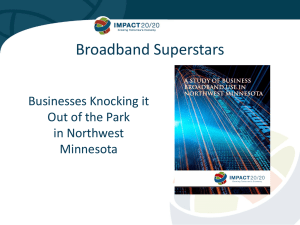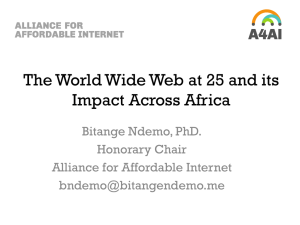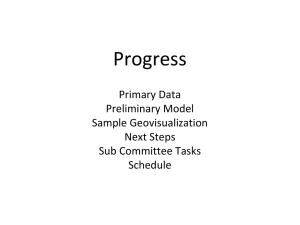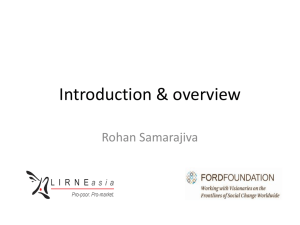Broadband Economy
advertisement
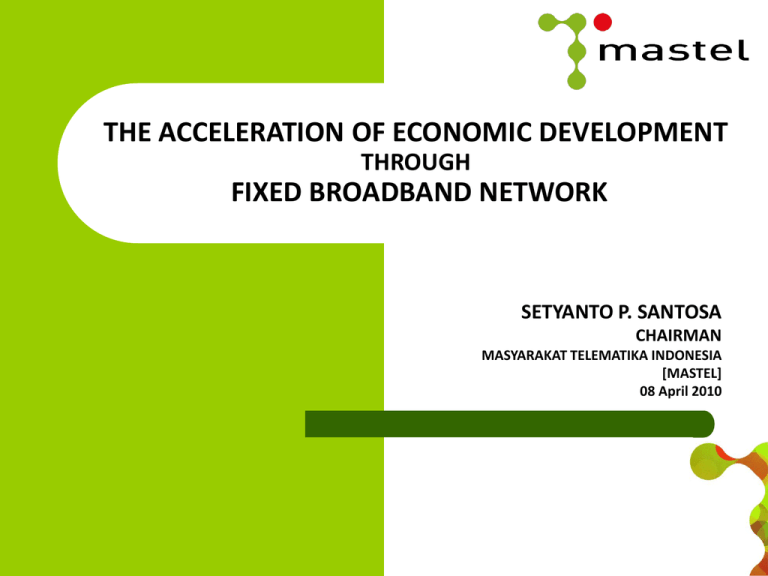
THE ACCELERATION OF ECONOMIC DEVELOPMENT THROUGH FIXED BROADBAND NETWORK SETYANTO P. SANTOSA CHAIRMAN MASYARAKAT TELEMATIKA INDONESIA [MASTEL] 08 April 2010 From Agricultural to Conceptual sps 08042010 2 The Information Revolution, Driver of the Knowledge Economy in a Global World sps 08042010 3 ROLE OF BROADBAND "for every one percentage point increase in broadband penetration in a state, employment is projected to increase by 0.2 to 0.3 percent per year” (brooking institute) sps 08042010 4 ROLE OF BROADBAND Broadband needs to be considered as basic national infrastructure, as it will fundamentally reshape the world in the 21st century and change the way services are delivered – from e-health to e-education to e-commerce to egovernment. Broadband is the most powerful tool ever devised to drive social and economic development, and accelerate progress towards the Millennium Development Goals. Broadband is becoming a prerequisite to economic opportunity for individuals, small businesses and communities. Those without broadband and the skills to use broadband-enabled technologies are becoming more isolated from the modern American economy. Broadband can provide significant benefits to the next generation of entrepreneurs and small businesses—the engines of job creation and economic growth for the country. sps 08042010 5 BROADBAND & SMEs It allows small businesses to achieve operational scale more quickly. Broadband and associated ICTs can help lower company start-up costs through faster business registration and improved access to customers and suppliers. It gives SMEs access to new markets and opportunities by lowering the barriers of physical scale and allowing them to compete for customers who previously turned exclusively to larger suppliers. It allow small businesses to increase efficiency, improve market access, reduce costs and increase the speed of both transactions and interactions. E-commerce solutions eliminate geographic barriers to getting a business's message and product out to a broad audience. 60 million Americans go online every day to find a product or service, but only 24% of small businesses use e-commerce applications to sell online sps 08042010 6 BROADBAND & ECONOMIC SECTORS OECD report urges governments to invest in open-access high-speed national fiber networks that can serve as the future delivery mechanism for a huge range of new and innovative public sector services. And despite the large initial capital investment needed – typically US$ 1,5002,500 per household connected – the report shows that National Broadband Networks can pay for themselves within ten years, through dramatic savings in just four key economic sectors: electricity healthcare road transport Education cost savings across the four sectors of just 0.5%-1.5% would be sufficient to justify the cost of laying high-speed fiber-to-thehome via a national point-to-point network. sps 08042010 7 The Positive Side of Indonesian ICT Development Mobile and Internet Tariffs are among the cheapest in SE Asia Large growths in Mobile Subscribers for several years The growing applications and contents in Internet and Mobile services, such as IP-TV, streaming videos, games, entertainments, BlackBerry, etc. Indonesia is among the World's largest users of Web 2.0 Social Networking, such as Blogs, Facebook, Multiply, Youtube, YM, Chatting, etc sps 08042010 8 The Negative Side of the Indonesian ICT Development The declining profit margins of Operators due to very intense tariff competition The lowering of Quality of Service, especially 3G and mobile Internet services Low or little profits from Web, Internet and Social Networks, due to average low income of Indonesians ICT growth has not been accompanied by economic growth; little value added results sps 08042010 9 ICT Indicators 2004-2008 2004 2005 2006 2007 2008 Fixed Telephones 8,703,300 8,824,467 8,806,702 8,717,872 8,612,872 Fixed WirelessPhones 1,673,081 4,683,363 6,014,031 10,811,635 16,598,550 Mobile Phones 30,336,607 46,992,118 63,803,015 93,386,881 124,805,871 SERVICES Population in 2008 = 228,523,300 Households in 2008 = 57,716,100 Income per Capita = Rp 7.5 millions PDB per Capita = Rp 8.7 millions per year % of Households with Fixed Phones = 12.69% (24.51% in cities, 3.72% in villages) sps 08042010 10 INFRASTRUKTUR DATA 2008 INDONESIA (UN E-Gov Survey 2008) Internet / 100 Users 7.18 PC / 100 Users 1.47 Cellular Subs /100 users 28.30 Main Telephone Lines/100 Users 6.57 Broadband / 100 Users 0.05 sps 08042010 11 E-Readiness Peringkat Kesiapan Teknologi 2008-2009 (Sumber: Global Competitiveness Report 2008-2009, World Economic Forum) Negara Thailand 34 66 Teknologi Maju 50 Indonesia 55 88 Vietnam 70 Philipina Daya Saing Daya Saing Teknologi Daya Serap Teknologi Regulasi TIK FDI dan Transfer Teknologi Jasa Seluler Pengguna Jumlah BroadInternet Komputer band 61 61 48 72 78 72 94 61 65 71 24 100 107 105 100 79 71 54 72 57 114 70 63 79 71 70 52 49 60 50 84 101 70 96 Sri Lanka 77 82 54 45 59 47 102 117 94 98 Kamboja 109 123 109 106 122 94 120 130 128 108 e-Readiness 2008 (Sumber: The Economist Intelligence Unit, 2007) Negara Thailand Philipina Sri Lanka Vietnam Indonesia Peringkat Nilai Total Akses Bisnis Sos Bud Hukum Kebijakan 47 55 60 65 68 5,22 4,90 4,35 4,03 3,59 3,80 3,20 2,95 2,25 2,30 6,99 6,56 5,80 6,31 6,49 5,07 4,53 4,80 3,80 3,53 5,90 4,50 6,30 4,40 3,20 5,25 5,20 4,10 4,60 3,40 sps 08042010 Adopsi Bisnis 5,10 5,45 3,70 3,75 3,20 12 Sumber : RPJMN 2009-2010 PERTUMBUHAN EKONOMI 7% YANG BERKEADILAN Target pertumbuhan ekonomi 7% pada 2014 membutuhkan dana ratarata Rp 2.000 triliun setiap tahun dengan komposisi: Pemerintah : 20% Swasta : 80% Bagaimana mengamankan 80% dana yang berasal dari swasta? Kepercayaan kepada Pemerintah Reformasi birokrasi Perbaikan pelayanan publik Pemberantasan korupsi, dst Iklim Investasi yang Kondusif Penyederhanaan prosedur perijinan Stabilitas makro ekonomi Perbaikan sistem logistik nasional, dst Dukungan Ketahanan Sosial Pengentasan kemiskinan Peningkatan kesehatan masyarakat Peningkatan kualitas pendidikan, dst Penguatan Pertahanan Pembangunan Infrastruktur Ketahanan Energi Ketahanan Pangan sps 08042010 13 Sumber : Bappenas 2009 paparan RPJMN MENGAPA FIXED BROADBAND ? Mostly dedicated sampai ke last-miles Wireless pada umumnya untuk low-traffic Infrastruktur Dasar Long-term investment Public Private Partnership Optimalisasi Pemanfaatan Palapa Ring Industri Kreatif sangat membutuhkan sps 08042010 14 Broadband for All TERIMAKASIH sps 08042010 15


